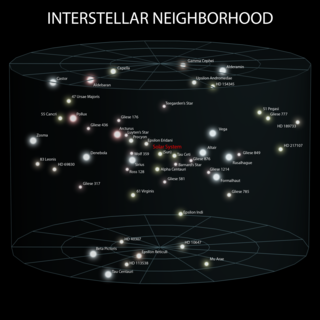Top Qs
Timeline
Chat
Perspective
List of nearest bright stars
From Wikipedia, the free encyclopedia
Remove ads
The following nearest bright stars are found within 15.0 parsecs (48.9 ly) of the closest star, the Sun, and have an absolute magnitude of +8.5 or brighter, which is approximately comparable to a listing of stars more luminous than a red dwarf. Right ascension and declination coordinates are for the epoch J2000. The distance measurements are based on the Hipparcos Catalogue and other astrometric data. In the event of a spectroscopic binary, the combined spectral type and absolute magnitude are listed in italics.

The list is ordered by increasing distance.
| A-type star |
| F-type star |
| G-type star |
| K-type star |
| M-type star |
Remove ads
Stars within 10 parsecs
Summarize
Perspective
These stars are estimated to be within 32.6 light-years of the Sun.
Remove ads
Stars between 10 and 13 parsecs
Summarize
Perspective
These stars are estimated to be from 32.7 to 42.4 light years distant from the Sun.
Remove ads
Stars between 13 and 15 parsecs
Summarize
Perspective
These stars are estimated to be from 42.5 to 48.9 light years distant from the Sun. A value of 48.9 light years corresponds to a minimum parallax of 66.7 mas.
Remove ads
See also
- Lists of astronomical objects
- Interstellar travel
- Lists of stars
- List of nearest stars and brown dwarfs
- List of star systems within 20–25 light-years
- List of star systems within 25–30 light-years
- List of star systems within 30–35 light-years
- List of star systems within 35–40 light-years
- List of star systems within 40–45 light-years
- List of star systems within 45–50 light-years
- List of star systems within 50–55 light-years
- List of star systems within 55–60 light-years
- List of star systems within 60–65 light-years
- List of star systems within 65–70 light-years
- List of star systems within 70–75 light-years
- List of star systems within 75–80 light-years
- Nearby Stars Database
- Search for extraterrestrial intelligence (SETI)
- Stellar parallax
Remove ads
References
- Allende Prieto, C.; et al. (June 2004), "S4N: A spectroscopic survey of stars in the solar neighborhood. The Nearest 15 pc", Astronomy and Astrophysics, 420: 183–205, arXiv:astro-ph/0403108, Bibcode:2004A&A...420..183A, doi:10.1051/0004-6361:20035801
- Anderson, E.; Francis, Ch. (2012), "XHIP: An extended hipparcos compilation", Astronomy Letters, 38 (5): 331, arXiv:1108.4971, Bibcode:2012AstL...38..331A, doi:10.1134/S1063773712050015.
- Butler, R. P.; et al. (July 2006). "Catalog of Nearby Exoplanets". The Astrophysical Journal. 646 (1): 505–522. arXiv:astro-ph/0607493. Bibcode:2006ApJ...646..505B. doi:10.1086/504701.
- de Mello, G. F. Porto; del Peloso, E. F. & Ghezzi, L. (April 2006). "Astrobiologically interesting stars within 10 parsecs of the Sun". Astrobiology. 6 (2): 308–331. arXiv:astro-ph/0511180. Bibcode:2006AsBio...6..308P. doi:10.1089/ast.2006.6.308. PMID 16689649.
- Gray, R. O.; et al. (July 2006). "Contributions to the Nearby Stars (NStars) Project: Spectroscopy of Stars Earlier than M0 within 40 pc-The Southern Sample". The Astronomical Journal. 132 (1): 161–170. arXiv:astro-ph/0603770. Bibcode:2006AJ....132..161G. doi:10.1086/504637.
- Henry, Todd J. (1 October 2006). "The One Hundred Nearest Star Systems". Research Consortium on Nearby Stars. Archived from the original on 28 November 2006. Retrieved 11 December 2006.
- Holmberg, J.; Nordström, B.; Andersen, J. (July 2009). "The Geneva-Copenhagen survey of the solar neighbourhood. III. Improved distances, ages, and kinematics". Astronomy and Astrophysics Supplement Series. 501 (3): 941–947. arXiv:0811.3982. Bibcode:2009A&A...501..941H. doi:10.1051/0004-6361/200811191. Note: see VizieR catalogue V/130.
- Mamajek, Eric E.; Hillenbrand, Lynne A. (November 2008). "Improved Age Estimation for Solar-Type Dwarfs Using Activity-Rotation Diagnostics". The Astrophysical Journal. 687 (2): 1264–1293. arXiv:0807.1686. Bibcode:2008ApJ...687.1264M. doi:10.1086/591785. Note: this is a "volume-limited" sample of stars within 16 parsecs of the Sun.
- Pasinetti Fracassini, L. E.; Pastori, L.; Covino, S.; Pozzi, A. (February 2001). "Catalogue of Apparent Diameters and Absolute Radii of Stars (CADARS)". Astronomy and Astrophysics. 367 (Third ed.): 521–524. arXiv:astro-ph/0012289. Bibcode:2001A&A...367..521P. doi:10.1051/0004-6361:20000451. Note: see VizieR catalogue J/A+A/367/521.
- Perryman, Michael (2010), "The Making of History's Greatest Star Map", Astronomers' Universe, Heidelberg: Springer-Verlag, Bibcode:2010mhgs.book.....P, doi:10.1007/978-3-642-11602-5, ISBN 978-3-642-11601-8
- Perryman, M. A. C.; et al. (1997), "The Hipparcos Catalogue", Astronomy & Astrophysics, 323: L49 – L52, Bibcode:1997A&A...323L..49P
- Takeda, G.; et al. (2007). "Stellar parameters of nearby cool stars. II. Physical properties of ~1000 cool stars from the SPOCS catalog". Astrophysical Journal Supplement Series. 168 (2): 297–318. arXiv:astro-ph/0607235. Bibcode:2007ApJS..168..297T. doi:10.1086/509763. Note: see VizieR catalogue J/ApJS/168/297.
- Valenti, Jeff A.; Fischer, Debra A. (July 2005). "Spectroscopic Properties of Cool Stars (SPOCS). I. 1040 F, G, and K Dwarfs from Keck, Lick, and AAT Planet Search Programs". The Astrophysical Journal Supplement Series. 159 (1): 141–166. Bibcode:2005ApJS..159..141V. doi:10.1086/430500. Note: see VizieR catalogie J/ApJS/159/141 Archived 6 August 2016 at the Wayback Machine.
- van Leeuwen, Floor (2007). "Hipparcos, the new Reduction of the Raw data". Astronomy and Astrophysics. Astrophysics and Space Science Library. 350 (2): 653–664. arXiv:0708.1752. Bibcode:2007A&A...474..653V. doi:10.1051/0004-6361:20078357. ISBN 978-1-4020-6341-1. Note: see VizieR catalogue I/311.
Remove ads
External links
- "SIMBAD Astronomical Database". Centre de Données astronomiques de Strasbourg. Retrieved 5 August 2006.
- "NStars database". NASA. Archived from the original on 1 November 2005. Retrieved 24 October 2005.
- "ARICNS". Astronomisches Rechen-Institut. Archived from the original on 14 October 2005. Retrieved 24 October 2005.
- "Notable Nearby Stars". SolStation. Retrieved 24 October 2005.
- "What color are the stars?". Mitchell Charity. Retrieved 24 October 2005.
Remove ads
Wikiwand - on
Seamless Wikipedia browsing. On steroids.
Remove ads
